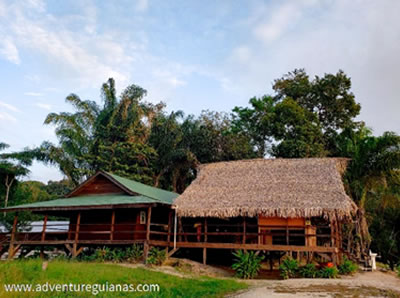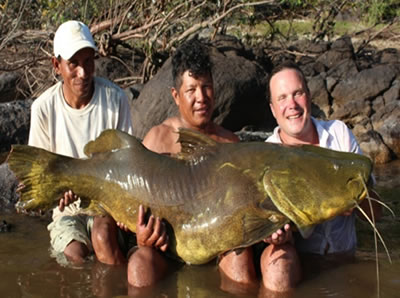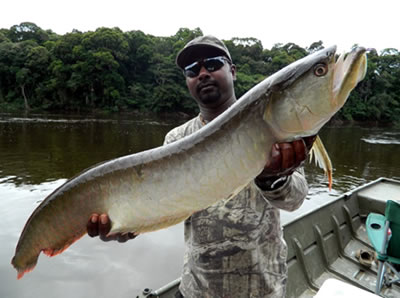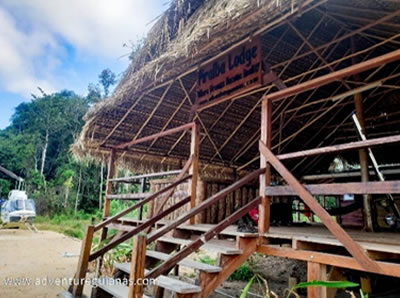Fishing and Wildlife Adventure to Piraiba Lodge
$1790 per person
Introduction: Guyana-Land of Many Waters
Guyana is located on the northeastern shoulder of the Continent of South America and is bounded by Suriname in the East, Venezuela in the West, Brazil on the South and South West and the Atlantic Ocean in the North-Northeast. Guyana currently has one on the largest tracks of undisturbed rainforest, accounting for more than 83 % of total land mass, due largely to its inaccessibility and centuries old civilizations of our Amerindian peoples, whom as custodians have lived on the land, relying on the rainforest and its’ rivers for food, medicine, shelter, weapons, and spiritual guidance.
About Adventure Guianas: Adventure Guianas is a registered Tour Company, certified by the Guyana Tourism Authority, based in Guyana, South America, which specializes in Fresh Water Fishing, in addition to Nature and Adventure Travels. Our Indigenous Guides, drawn from nearby Amerindian Villages, provides all the requisite skills and knowledge to ensure an unforgettable experience. We therefore encourage you to be part of a remarkable and unique sport fishing experience deep into the Essequibo River; an area unexplored and uninhabited, with wildlife and natural beauty.
Whilst every effort would be made to assist, entry requirements (Visitors Visas) are the sole responsibility of Clients. Terms and conditions of payments: 75% as deposit on reservation, 25% due 3 days before commencement of tour.
Download and print -:- Fishing and Wildlife Adventure to Piraiba Lodge Itinerary.
For extended trips, each additional day of fishing costs USD$200 Per person.
Included:
-
- All domestic flights
- Transport to river
- All food and beverages, inclusive of one Bottle of our Gold Medal Rum-The El Dorado (additional alcohol can be pre-ordered) while in camp and while fishing
- Based on double occupancy.
Excluded:
-
- Any tips
- Lures, jigs, tackle etc. – We can however, provide certain tackle upon request at a nominal cost.
- Each person will be allowed a maximum of 20 lbs weight, to take on the Aircraft. Additional weight can be pre-arranged at the client’s expense.
Day 1: Friday
Day 2 & 3: Saturday & Sunday
Day 4: Monday
Day 10: Historical Tour
The Place
Essequibo, Guyana’s largest and one of  South America's longest River, is perhaps the most unfrequented of its kind. This remote and pristine corner of the eastern Amazon basin is home to a myriad of fresh water fish species, no lesser than the Arapaima.
South America's longest River, is perhaps the most unfrequented of its kind. This remote and pristine corner of the eastern Amazon basin is home to a myriad of fresh water fish species, no lesser than the Arapaima.
The Lodge
Guests will sleep in Piraiba Lodge, which 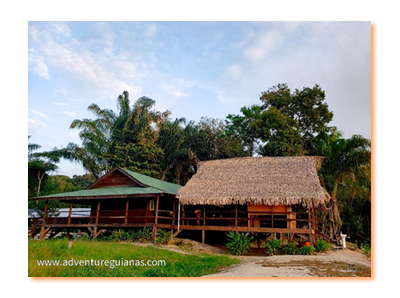 has six (6) self-contained rooms-each with two queen size beds, 24 hrs electricity, powered by a photovoltaic (Solar) system equipped. The Lodge is situated on the eastern bank of the Essequibo River, surrounded by pristine jungle full of wildlife. Additionally, Coleman Weather Proof Tents- 11 ft *17 ft, and Sleeping Cots, set on the banks of this delightful river, under the tree canopy, are available for the Hard-Core Anglers who may want to fish off the river bank during the night. There is also four (4) additional rooms and a separate toilet and bath facility, located outside of the Lodge. For extended trips, we move Camp to other parts of the river in search better fishing grounds. This can be arranged prior to the trip. A satellite phone is available at all times for use at a nominal cost.
has six (6) self-contained rooms-each with two queen size beds, 24 hrs electricity, powered by a photovoltaic (Solar) system equipped. The Lodge is situated on the eastern bank of the Essequibo River, surrounded by pristine jungle full of wildlife. Additionally, Coleman Weather Proof Tents- 11 ft *17 ft, and Sleeping Cots, set on the banks of this delightful river, under the tree canopy, are available for the Hard-Core Anglers who may want to fish off the river bank during the night. There is also four (4) additional rooms and a separate toilet and bath facility, located outside of the Lodge. For extended trips, we move Camp to other parts of the river in search better fishing grounds. This can be arranged prior to the trip. A satellite phone is available at all times for use at a nominal cost.
Wild Life
With an endless diversity of flora and  fauna around every corner, this river is a professional and amateur photographer’s dream. Otters, Peccaries, Tapirs, Agoutis, Monkeys and many other mammals can be seen, with the elusive Jaguar sometimes along the river banks, feasting on River Turtles etc. Birds of every shape, color and size can be seen everywhere throughout these watersheds and many species of Parrots are heard all day long fighting over space and territory. Toucans call to each other from the treetops like yapping puppies and Herons, Egrets, Kingfishers, Terns and Ospreys frequent the river banks in search of fish.
fauna around every corner, this river is a professional and amateur photographer’s dream. Otters, Peccaries, Tapirs, Agoutis, Monkeys and many other mammals can be seen, with the elusive Jaguar sometimes along the river banks, feasting on River Turtles etc. Birds of every shape, color and size can be seen everywhere throughout these watersheds and many species of Parrots are heard all day long fighting over space and territory. Toucans call to each other from the treetops like yapping puppies and Herons, Egrets, Kingfishers, Terns and Ospreys frequent the river banks in search of fish.
The Species
Arapaima-Arapaima Gigas -Also  known as the Paiche or the Pirarucu, the Arapaima is an air-breathing fish that plies the Rainforest Rivers of South America's Amazon Basin and nearby lakes and swamps. The world's largest scaled freshwater fish, these giants can reach 9 feet (2.75 meters) long and weigh up to 440 pounds (200 kilograms). They survive mainly on fish but are known to occasionally grab birds close to the water's surface. The Amazon's seasonal floods have become part of the Arapaima's reproductive cycle. During low-water months (February to April) Arapaimas construct bottom nests and females lay eggs. Young begin to hatch as rising water levels provide them with flood conditions in which to flourish. Adult males play an unusual reproductive role by incubating tens of thousands of eggs in their mouths, guarding them aggressively and moving them when necessary. Unlike other parts of the world, Arapaima’s population in Guyana is healthy, due largely to an aggressive Protective Management Plan.
known as the Paiche or the Pirarucu, the Arapaima is an air-breathing fish that plies the Rainforest Rivers of South America's Amazon Basin and nearby lakes and swamps. The world's largest scaled freshwater fish, these giants can reach 9 feet (2.75 meters) long and weigh up to 440 pounds (200 kilograms). They survive mainly on fish but are known to occasionally grab birds close to the water's surface. The Amazon's seasonal floods have become part of the Arapaima's reproductive cycle. During low-water months (February to April) Arapaimas construct bottom nests and females lay eggs. Young begin to hatch as rising water levels provide them with flood conditions in which to flourish. Adult males play an unusual reproductive role by incubating tens of thousands of eggs in their mouths, guarding them aggressively and moving them when necessary. Unlike other parts of the world, Arapaima’s population in Guyana is healthy, due largely to an aggressive Protective Management Plan.
Other Species;  On lures, stocky, hard-fighting Yellow Butterfly Peacock Bass to over 15lbs and Himara/Wolf Fish to over 40lbs Slash-and-grab Payara/Vampire Fish, acrobatic Pike-like Arrawana to over 18lbs, sinister Black Piranhas over 8lbs and the Silver Drum Pescada/Corvina to over 12 lbs. Nut and fruit eating Pacu can be caught on spinners, soft baits, fruit, nuts and even weeds.
On lures, stocky, hard-fighting Yellow Butterfly Peacock Bass to over 15lbs and Himara/Wolf Fish to over 40lbs Slash-and-grab Payara/Vampire Fish, acrobatic Pike-like Arrawana to over 18lbs, sinister Black Piranhas over 8lbs and the Silver Drum Pescada/Corvina to over 12 lbs. Nut and fruit eating Pacu can be caught on spinners, soft baits, fruit, nuts and even weeds.
-
- 1 x Heavy 6’6”–7’6” bait casting or spinning rod matched with a bait casting or spinning reel with capacity of min. 150m of 65-80lb braid. This heavier outfit is needed for the larger Cats and Arapaima.
- 2 x Medium-Heavy 6’6”–7’6” bait casting or spinning rods with bait casting or spinning reels with capacity of min. 120m of 30-50lb braid. These slightly lighter outfits will handle casting and using smaller surface lures like Spooks and subsurface lures like minnow baits and jerk baits.
- 1 x Medium or Medium/Light 6’6”–7’6” spinning rod matched spinning reel with capacity for min.120m of 30lb braid. This much lighter outfit will give your arms and wrists a rest from ripping bigger baits and will allow you to easily use jigs and smaller minnow baits.
- Always bring spare line
-
- 8-10Wt fly rods matched with fly reels with good, smooth drag systems, loaded with a tropical, fast-sinking 300 grain, a tropical intermediate and a tropical floating fly lines with at least 100m of 30lb backing.
- 1.5m x 30-50lb straight nylon can be used for leaders (Peacocks, Payara and Bicuda are NOT leader shy). We advise a good pair of stripping gloves unless you want another lifeline burnt into your palm. A heavier outfit is needed if aiming for Arapaima on fly!!
- Rapala X-Rap Walk 13
- Rapala Skitter Pop SSP12
- Storm Chug Bug Madflash CBM11
- Yo-Zuri Mag Popper 13cm
-
- These type of lures can garnish the most explosive strikes and undoubtedly the best lures for Peacocks on the surface are small Prop baits, Stick baits/Spooks and Poppers.
- 5-6 x Medium-sized Prop baits like the 4.25” single and double propeller Caribe Pavon Props, 4.5” Highroller Riprollers and Rapala Skitter Props are ripped across the surface in a steady short cadence, ‘rip, pause, rip, pause’, all the way back to the boat
- 6-8 x Spooks and other medium cigar-shaped stick baits are used with a walk-the-dog, side to side, swishing action that ‘sways’ the lure like a snake across the water. This is a more subtle, quieter lure used when Peacocks tend to be less aggressive, or simply to garnish an explosive strike. Excellent lures on mirror-glass smooth water.
- 5-6 x Poppers can also work well and if used properly, they catch a good
- number of big fish. They should spit and gurgle and spray water in front, rather than ‘bloob’ or ‘pop’ and the best we have found is the Skitter Pop or the Saltwater Chug Bug skimmed along the surface with a cadence as in the prop baits.
-
- Shallow lures are mostly used when the top water bite is off or slow, or you just simply want to catch fish. While top waters are good ‘search and find’ lures and the angler gets a full-on experience with an explosive surface strike from fish like Peacock Bass and Himara, it is safe to say that sub-surface lures will always catch you more fish and more fish species.
- 10-20 x Minnow baits and crank baits will always work well in most situations and our choices are shallow running 4-6” Rapala X Raps, X Rap Sub Walk, Rattle Traps, Cotton Cordell Redfins and Yozuri Tobimaru and Crystal minnows. If a fish misses a top water strike, cast a minnow bait behind the swirl as a follow-up lure and you should hook up instantly.
-
- Deeper diving lures will get down to where Payara/Vampire Fish and bottom-hugging Traiarão/Himara lurk in wait for passing baitfish. Take a while to troll a likely looking area or deep hole to pick up a few fish.
- 3-5 x Deep minnow baits with our choice being Deep running X Raps and CD 14’s and 18’s.
- 10-20 x Buck tail jigs. The #1 lure for catching Peacock Bass of all sizes (or most sport fish anywhere in the world) is undoubtedly the 1/2oz 6-7”
- Buck tail jig with extended tail. They can be tied up in so many productive colour combinations. They are cast and stripped back to the boat.
-
- Yellow Peacock Bass, Payara/Vampire Fish, Himara/Wolf Fish, Bicuda and Silver Drum Pescada/Corvina will all take flies, but the Peacocks and Payara are the main species we seek here. Peacocks stack up around rock islands, structure and trees and will readily strike at any fly in their ‘zone’.
- Payara and Bicuda will migrate up and down the river hunting for baitfish and are often caught in the rapids and in eddies below cascades and falls. Both species are incredibly acrobatic and will always put on a real show.
- Amazon fly patterns, in general, are either tied in big 6-8” long-profile streamer flies with lots of flash, with and without weighted eyes or popper-type surface flies. Flies will attract and catch many more fish than other lures as they stay in the strike zone for longer. Usually a fast strip is used on streamer flies and a series of gentle, constant ‘spits’ for the surface flies. Don’t waste too much time on too elaborate fly patterns as
- Piranhas will eat plenty!! Go simple!
- *Always use a short leader with flies. Many fish here are real toothy critters!
- Sampo Solid Ring Ball-Bearing Swivels – Nickel at Cabela's
Catfish and arapaima rigs:

-
- If thinking of getting into some of the bigger boys here, then you might want to ‘butch up’ your gear to a more substantial rig.
- An XH Cat rod with either a baitrunner reel or large capacity baitcaster loaded with 100lb braid will serve you well.
- Simple rigs with a heavy lure baitcasting set-up with a 2oz egg sinker, 1 ½ ft of stiff wire leader (against the Piranhas!) attached to a strong swivel at one end and a 8/0 – 12/0 circle hook on the other is all that is needed. The hook is baited with fish cutbait and lobbed out into a deep hole. You do not need to strike when using circle hook rigs as the Cat will hook itself when running with the bait, with a 100% hook up rate in the corner of the mouth. Just raise the rod slowly, not striking, for a good hook set!
- We recommend clients follow the list of items below to keep to the weight restrictions. The list is really simple. Laundry is done daily, so only one or two changes of clothes are needed at camp.
- Clothes for the jungle are shorts or long pants, a shirt and a hat!! One change of clothes can be used for travelling.
- For travelling - 1 x pair lightweight shoes, socks, underwear, light jacket, 1 x light shirt and long cargo pants with pockets for documents, money, passport etc.
- For fishing - 1 x wide brimmed hat or fishing cap (with neck cape), 2 x lightweight tropical shorts or long tropical pants (zip-off’s are a good idea and can also be used as travel pants), 2 x tropical long or short-sleeved shirts (can also be used as travel shirt), 1 x pair of either CROCS, sandals or similar boat shoes, 1 x lightweight rain suit/jacket and 2 x pairs of polarised sunglasses.
-
- It gets hot out there in the full sun, often over 90ᵒC, so come well protected with good-quality sun-block with at least 50-75 SPF. Lip cream is essential.
- In some areas, we fish there can be mosquito activity, so bring an insect repellent (jungle formula with D.E.E.T), to keep them at bay. No-see-ums can appear on overcast days so spray ankles and elbows!. While some insects can be irritating while fishing during the day, the majority will not bite but harmlessly buzz around or land on skin or clothes.
- Bring any personal medications and allow for headaches, stomach upsets, fevers, infections, allergies etc. A medical kit is at camp at all times.
- Personal toiletries, soap, shampoo, toothpaste, toothbrush, shaving gear etc. A small amount of talcum powder is a valuable asset in the jungle for those sweaty areas!
- Reading book/magazine, pen and paper for notes.
- Small torch and spare batteries.
- Lightweight digital camera.
- Multi-tool.
- Boga Grip or other fish handling device.







